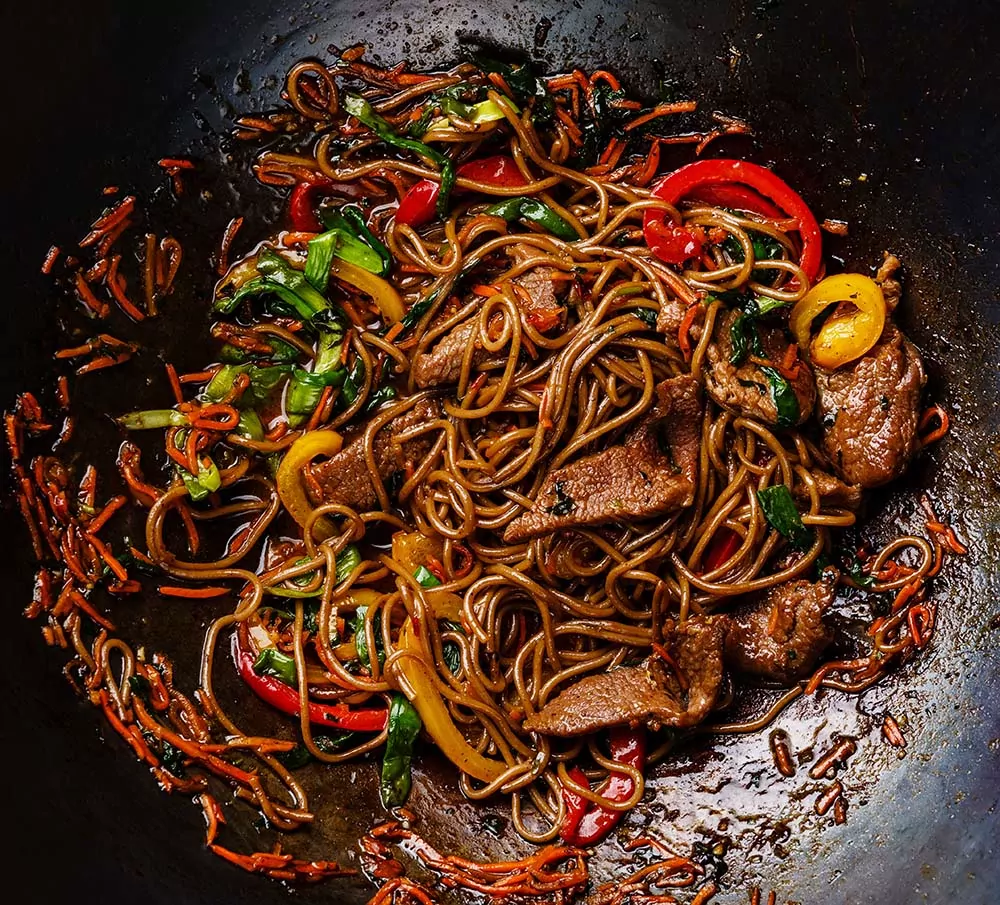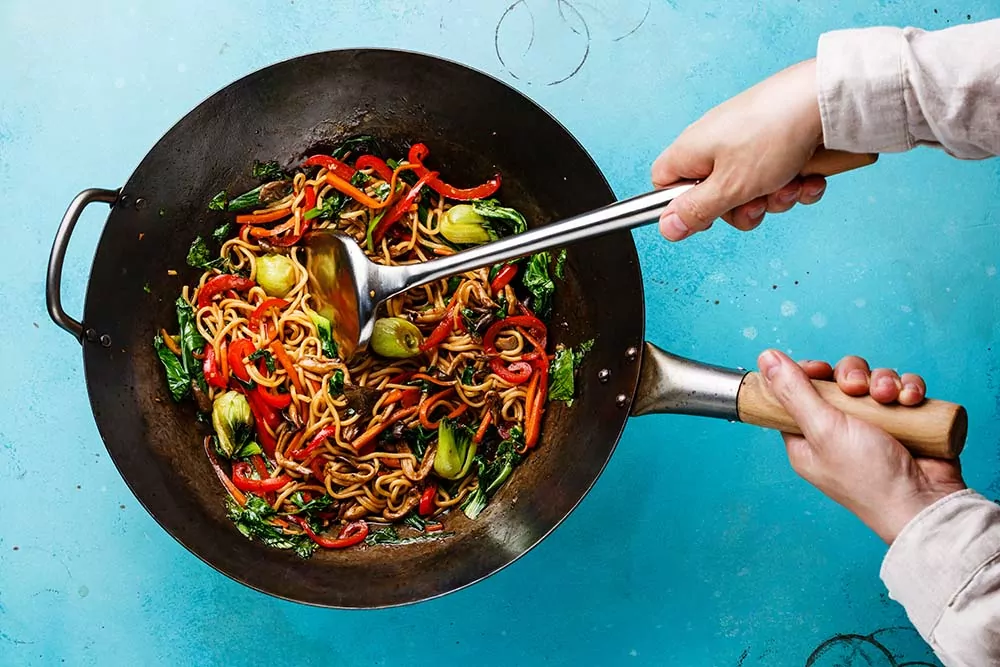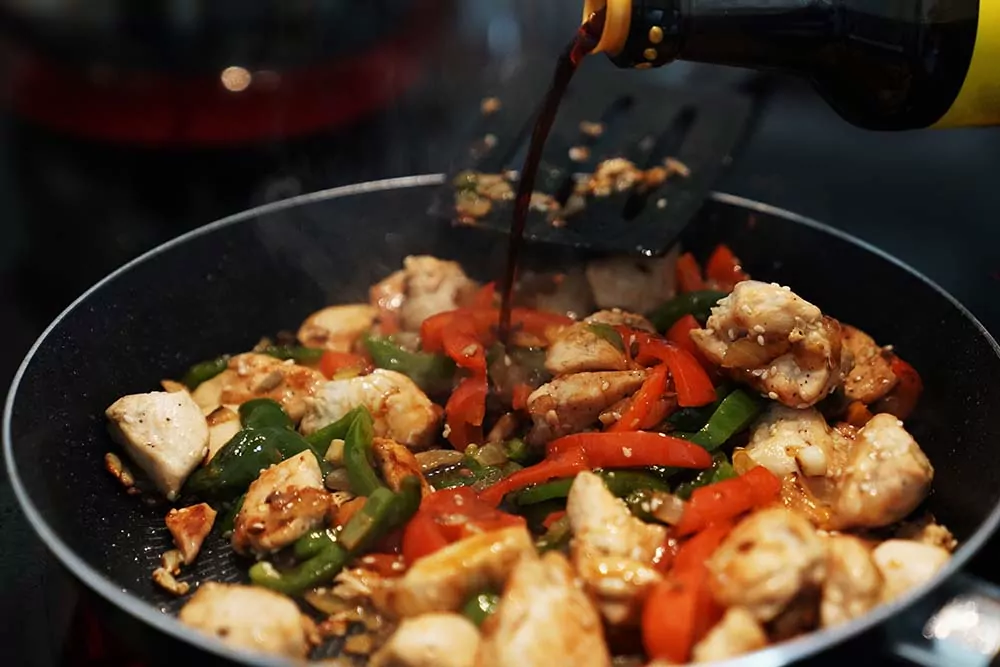While trying to create restaurant quality meals at home, whether they be Asian cuisine or more free form, you’ve probably thought about one key decision: the wok vs the stir-fry pan.
There are only a few sights in the kitchen more compelling than a chef tossing a stir-fry in a blazing wok, flames and steam pouring out from every angle. It’s nearly impossible to look away from the flaming heart of that screamingly hot fire and the delicious food being tossed inside the deeply sloped sides of the wok. Or maybe you’ve seen a chef slip a whole fish into a wok brimming with shimmering and smoldering oil, pulling it back out only a few minutes later covered in a beautiful and crispy golden crust.
On the other hand, at home you may have already had some experience whipping up delicious stir-fries in a stir-fry pan. These pans may not have the same searing hot allure of a wok, but they get the job done and they get the job done well. Easily accessible, easy to use with all sorts of different kitchen set-ups, and easy to clean, a stir fry pan might really be the way to go.
So, what is the deal exactly with woks? Why do they work so well? What’s the real difference between a wok vs a stir-fry pan?
The answer lies mostly in the type of kitchen setup you have at home, and how much you want the classic wok stir-fry taste.
What’s a Wok?

A wok is a particular type of cooking device most frequently associated with Chinese cooking, though it is widely used across South East Asia as well. It’s a type of round-bottomed pan with tall, sloped sides. This shape is its most distinctive feature.
The round bottom and high sloped sides of a wok allow it to be placed on extremely hot flame sources, like a brazier, that in some cases send flames all the way up to the very rim of the wok.
The sloped sides also make tossing food particularly easy. The angled sides basically act as a ramp, allowing you to quickly and repeatedly toss food in the air. This allows you to use sauté and stir-fry techniques not possible with a standard sauté pan with vertical sides.
Most modern woks have two handles: one long handle that stays cool even when the wok is over the flames, and a loop on the opposite side to make lifting it easier. Some more classical style woks only have two loop handles, but this is less common for modern commercial woks.
Woks have a nearly 2000 year history in the Chinese kitchen, and for good reason. They are incredibly utilitarian pieces of equipment and can be used for a whole host of cooking techniques. Many well made woks also have an extremely long lifespan, staying useful for as long as a whole century.
Woks are excellent at heat retention and can be heated to incredibly high temperatures. There really is no better tool for quick cooking and no other pan comes close in the temperature department.
Woks also have excellent heat dispersion that few other pans can compare to. The concave shape ensures that there are no cold spots at the base of the pan, and the radiant heat keeps the sides at a slightly cooler but consistent temperature. Heat dispersal is a key thing to consider when choosing any type of pan, and woks in particular excel here.
While woks have many uses in the kitchen, they are probably best known as the ultimate tool for stir-fries. The most famous example is perhaps the so-called “Bao Technique.” Bao means “pop” or “explosion” in Chinese and it refers to the process of heating a wok to searing red hot temperatures and then tossing the food continuously while it cooks to impart a distinct smoky flavor, particularly prized in Cantonese cuisine.
Why Use a Wok?
Steaming, frying food, stir-frying, deep fry, toasting nuts and spices. All this is possible with a wok. What’s more, the concave base of a wok will save you a ton of oil when frying small foods like garlic slices or crispy shallots!
While woks are most famously used to make stir-fries, the potential for different types of cooking techniques in a woks is nearly limitless. They can be used as the bottom half of a steamer, they’re great for conserving oil when frying small foods like garlic, and woks even make it easy to deep fry even large foods.
The best part about a wok is just how hot it can get. Since they are frequently used in conjunction with the extremely focused flame of a gas burner or brazier, the temperature at the center of a wok climbs incredibly rapidly and is retained particularly well. This also means that woks cook food very quickly, much faster than many other techniques and tools.
This is where the sloped sides come into play. Since woks get extremely hot, you need to be able to move food around in them constantly to ensure that they don’t burn. The angled sides make this a breeze.
One of the most unique strengths of a wok is the variable temperature it produces across its surface. It’s at its hottest right at the center of the bowl, but is considerably cooler up on the sides. Unlike with most flat bottomed pans, by moving food around the wok you can change the amount of heat that is being applied giving you an extremely high level of control over the cooking process.
Different Types of Wok
When picking a wok, you have a number of different choices for both the material the wok is made of and the shape of the pan itself. Some of the most common materials include cast iron and carbon steel, though more recently stainless steel woks have also become popular.
You also have the choice between a more classic wok shape and a flat bottomed wok. The choice here will come down to your kitchen setup and what kind of burners you can use.
Traditional Wok
A traditional wok is designed with a very concave bottom and only fits on certain types of wok burners. These burners output between 50,000 to even 250,000 BTU, while home burners usually max out around 11,000 BTU. These aren’t suitable for electric stoves or even most home gas burners without certain adapters.
Flat Bottom Wok
A flat bottom wok is exactly what it sounds like, a wok with a flat bottom. It may be flat where other woks are curved, but it still has the classic deep sloped sides of any other wok. The key here is that with a flat bottom they can be used on electric stoves whereas it is practically impossible to use a round bottomed wok without a gas burner of some kind.
If your house has an electric stovetop or you are for some reason unable to modify your gas burners, a flat bottom wok is by far the best choice.
It should be noted however, that since the bottom is flattened and considerably wider than a standard wok, the heat dispersal will be different and it will generally require more oil to use properly. Usually, the top third of the flat bottomed wok will not get nearly as hot as the sides of a more typical wok would.
Don’t fret, though. Many Chinese households use flat bottomed woks because they too only have access to an electric stove and not the high power burners that power professional kitchens. A flat bottom wok is an excellent substitute for home cooking if you have an electric stove at home.
Carbon steel wok

Carbon steel is one of the most popular options today because it is lightweight and thin, but still incredibly durable.
When seasoned properly, carbon steel is completely nonstick. However, if not seasoned and dried after each use, carbon steel is prone to rust.
Carbon steel is also quite cheap compared to some other options, but still high quality.
Many chefs also prize carbon steel for its ability to put extremely hard sears on food and also impart the famous smoky flavor associated with Cantonese cuisine and dry stir-frying. Carbon steel woks have a special place in the cooking pantheon and are able to do things other materials just can’t.
Cast Iron
Cast iron is probably the first material woks were made of and it still enjoys a lot of popularity today. Cast iron does weigh significantly more than carbon steel, though.
Overall, cast iron and carbon steel have many of the same structural properties. Both are completely oven safe and tend to come in on the cheaper side. The main difference is simply in weight and size.
Cast iron woks, as a rule, will be thicker and heavier than carbon steel woks. They will retain heat a bit longer due to their thickness and heat up slightly slower, but that’s where the differences pretty much end. Between the two options, it basically comes down to personal preference.
If you find that you really love your cast iron skillet, this could be the choice for you.
Stainless steel
Stainless steel woks have inferior heat conductivity, tend to be thicker and heavier, but are also easy to clean. Since stainless steel is not reactive, there is no risk of rust and they tend to even be dishwasher safe, unlike carbon steel and cast iron.
Wok Ring
If you have a gas stove at home, the simple addition of a wok ring can work wonders. By just replacing a normal grate and gas ring on a gas stove, it provides a stable seat for the wok to fit into.
That being said, while a wok ring will allow you to adapt your gas stove top, it will also raise the wok away from the heat source which makes the ultra high heat searing usually possible with a classic wok setup very difficult, if not impossible.
Wok Spatula
It’s also key that you get yourself a wok spatula if you intend to cook with a wok. These long handled spatulas allow you to reach into the bottom of a wok while cooking without burning yourself to quickly toss and turn food inside the wok. For many chefs, a wok ladle is equally indispensable for adding various liquids and sauces to a wok.
What about a stir-fry pan?

In the last thirty or forty years, stir-fry pans have become widely produced for home cooks. While evocative of the shape of a classic wok, the stir-fry pan has a wide and completely flat bottom. It’s height tends to come in somewhere quite a bit lower than the average wok, but still higher than the common European sauté pan.
They also tend to be thicker than woks, especially the carbon steel woks.
Their curved sides are also designed to make tossing food easy and effortless, and they almost always can fit a lid.
The lid is one place the stir fry pan has an edge over woks. Wok lids are specialized pieces of equipment that need to be bought separately. Many stir-fry pans already come with a lid and if they don’t, they can easily fit lids from other similar sized pans.
The addition of a lid lets you lightly steam food as you’re cooking it. Closing the lid on a vegetable stir fry for just a minute or two will greatly expedite the cooking process and ensure that all your food is cooked evenly.
These stir fry pans will also frequently come with nonstick coatings. This means that there’s no need to season your pan and absolutely no risk of rust. Nonstick coatings are very useful and make for an all around easier cooking experience, but they cannot be heated to high temperatures without damaging the coating.
In general, while making a stir fry that includes lots of sauce you’ll notice less of a difference between a stir fry pan and a wok. Most sauces burn pretty easily and quite quickly if exposed to too high of a temperature, so the flash searing capability of wok is significantly less useful. Since you can toss the food much the same way in a stir fry pan as you would in a wok, you won’t find much of difference between making a chow mein like this one with easy to burn soy and oyster sauce in a wok vs a stir fry pan.
If you like saucy stir-fries and aren’t interested in making dry stir-fries at home, go for the stir fry pan. It can easily produce great food and is simply the more utilitarian option.
Final Comparison
A stir-fry pan will be easier to use and care for. It is also more likely to make sense with your home kitchen setup. But it won’t be able to achieve the distinct smoky character of wok cooked dishes.
It should be noted that woks do require more specialized equipment. Without a proper gas burner, wok ring, or long handled wok spatula, it will be difficult to utilize the wok properly.
A wok also has a distinct learning curve. Learning heat control and how to quickly toss food is an acquired skill that takes time to learn. And if you’re using a cast iron or carbon steel wok, you have to know how to properly care for it.
The main takeaway is this: For most home cooks a stir-fry pan offers more flexibility in terms of which cooking surfaces it can be used on. That being said, there are many things only possible with a wok that just aren’t the same when done in a stir-fry pan.
A stir-fry pan will never imitate the ultra fast cooking and smoky flavor that a wok provides. It also just doesn’t have the same unique heat distribution since its flat base stays at a consistent temperature and the sides don’t heat up as much.
If you’re looking for ease of use and want to create some very decent stir-fries at home, go with a stir-fry pan. If you’re looking for the particular taste and feel of a classic stir-fry and want to able to use other cooking methods with your pan, get a wok. When it comes to a flat bottom or traditional wok, just get what works for your stove top.
